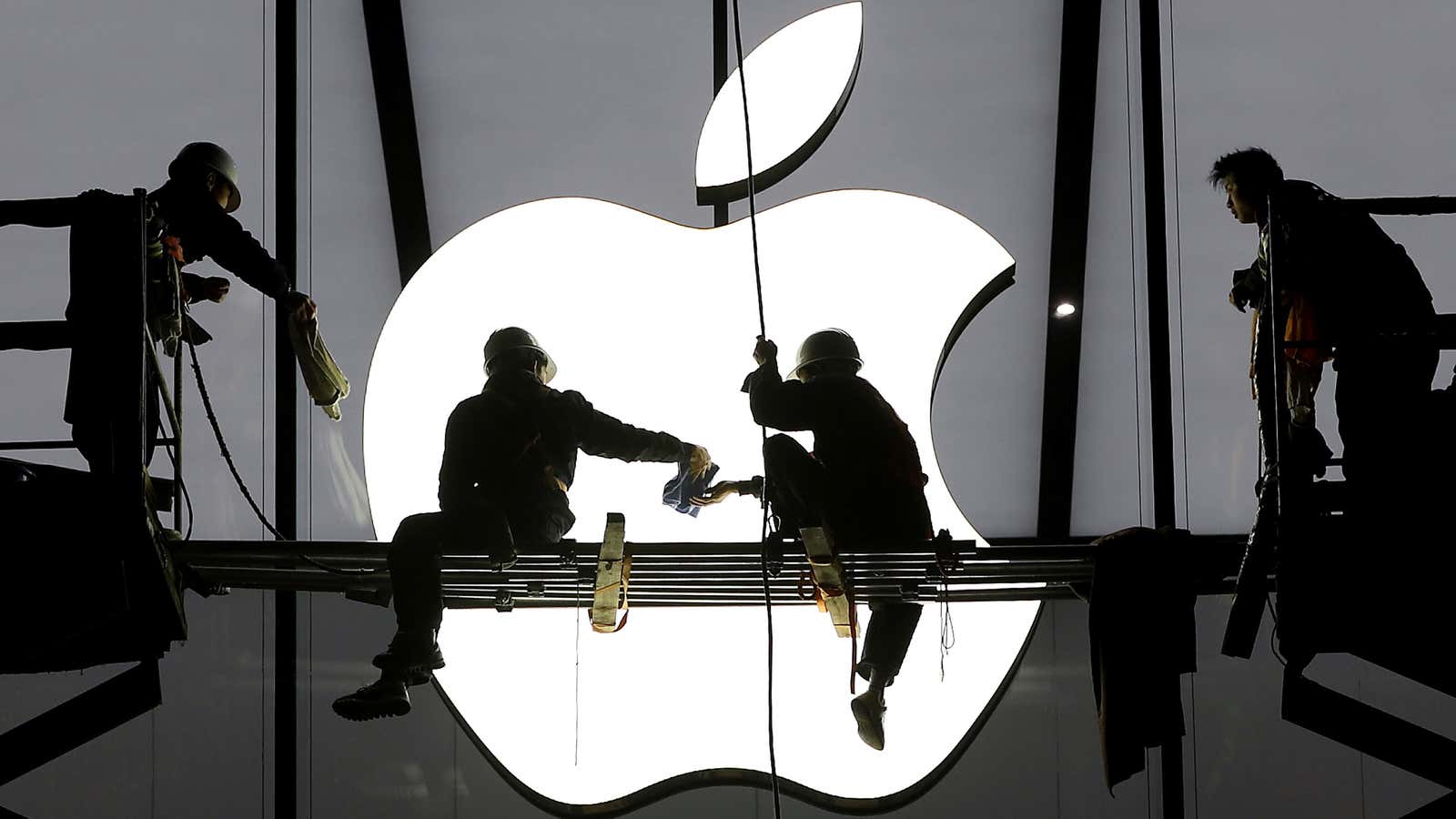On yesterday’s earnings call, it became clear that a trend is emerging for Apple: iPhone sales are falling, and accounting for a smaller portion of the company’s revenue than they had in recent quarters. But while investors weren’t particularly perturbed—the market spiked in after-hours trading, and Apple’s sales weren’t as bad as Wall Street had been expecting—it does start to make one wonder about what the company has planned for the longer-term future, if iPhone sales continue to slump. And the answer may lie in the large amounts of money Apple is spending on research, and the massive amounts of cash the company continues to hold.
Apple spent $2.56 billion on research—more than it spent in any year-long period before 2012—in just this past quarter alone. It’s spent $7.5 billion on research for the year, and is on track to outpace last year’s spend, according to its earnings statement.
As Quartz has suggested before, Apple can’t possibly be spending all that money on making the iPhone a little thinner, or making a slightly better pencil for the iPad. But, other than speculations and rumors, there hasn’t been proof that the company is working on much beyond its existing product lines—until now. Answering a question from an analyst on the earnings call, Cook explained the company’s strategy behind its ballooning spending on research and development. “On the R&D growth, we do continue to invest significantly,” Cook said, adding:
The balance of the company, we’re managing more flattish from a year-over-year point of view. The products that are in R&D, there is quite a bit of investment in there for products and services that are not currently shifting or derivations of what is currently shipping. And so I don’t want to talk about the exact split of it. But you can look at the growth rate and conclude that there’s a lot of stuff that we’re doing beyond the current products.
Apple is now spending more on research than most major car companies, and only a little less than companies like Google and Facebook, both of which are building drones, and working on other zany, expensive projects, like household robots, internet-beaming weather balloons, and virtual reality. All of these likely cost a fair bit more than the research required to revamp the next iPad.
But unlike its Silicon Valley neighbors, Apple hasn’t really given us any indication of what its future holds, or how it’s spending its research budget. That’s not Apple’s style. But the sheer amount of money in question gives some credence to the more fanciful rumors and reports on what the company’s up to. A self-driving car? More robots to complement the recycling bot it revealed earlier this year? In his opening remarks on yesterday’s call, Cook also spoke of how artificial intelligence, machine learning, and deep learning will be “enriching” the company’s products in the near future.
On the call, an analyst referenced the runaway success of the augmented-reality (AR) mobile game, Pokémon Go, and asked if this was something Apple was also exploring. Although Cook called the game’s characters “pokey mans,” he suggested that the underlying technology may be an area of focus for the company:
It also does show, as you point out, that AR can be really great. And we’re—we have been and continue to invest a lot in this. We are high on AR for the long run. We think there’s great things for customers and a great commercial opportunity. And so we’re— we’re investing, and the number one thing is to make sure our products work well with other developers’ kind of products like pokey man. That’s the reason why you see so many iPhones out in the wild chasing pokey mans.
And then there’s the massive pile of cash that Apple also holds. While the company likely can’t spend it in the US (for fear of huge tax levies), it’s indicated with its investment in Chinese ride-hailing company Didi Chuxing that it intends to spend at least some of it investing in innovation around the globe where there is a strategic need to do so.
Google has shown its intent to diversify how it makes money, away from just advertising dollars on search, buying companies like the internet-of-things hardware company Nest (although not without hiccups), and robotics companies like Boston Dynamics and Schaft. It also invests heavily in startups through its venture arm, and has a “moonshot” lab where it works on zanier ideas for its company called X. On yesterday’s call, Cook said Apple buys a new company every three to four weeks, on average.
Perhaps in the near future, in an attempt to move beyond falling iPhone sales, the company will spend more of its massive cash pile strategically investing in more foreign companies, as it did with Didi, and as it has done in the past with companies like chip manufacturer ARM and cloud services company Akamai—both of which Apple has used extensively in its own products. ”We obviously invest a ton of capital in our business itself to support research and development and the production of our products, and that’s sort of the main source of our capital.” Cook said on the call. “However, we’re constantly looking on the outside for great talent and great intellectual property.”
“Would we do more investments? Yes,” he said. ”But it’s not a something that you’ll see a whole string of from us. But we will, you know, constantly look for things that are smart to do.”
